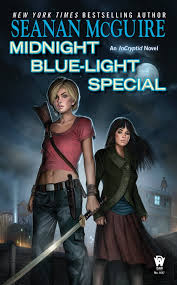In case you haven’t been reading McGuire’s InCryptid series,
here’s what you need to know so far: A
cryptid is a creature whose existence has been suggested but not proven. This would include mythological stories about
dragons and gorgons as well as more modern stories about Bigfoot or chupacabras. The Covenant of St George is an ancient
society dedicated to the extermination of all cryptids. A few generations ago the Price family came
to America and left the Covenant. The Prices think that humans and cryptids can
live together peacefully. And the
Covenant thinks they’re all dead.
Midnight Blue-Light
Special focuses on Verity Price, the young Price daughter living in NYC in
order to follow her dreams of being a ballroom dancer. She learns that the Covenant is sending a
team to New York. Their report could
lead to the Covenant exterminating all the cryptids in the city. And things will just get worse if they learn
that the Prices are still alive.
On a surface level, the InCryptid series is like most urban
fantasy series. There’s a young female
protagonist, who is beautiful and a badass.
The story is told in first person, with a quippy narrative voice. The heroine has friends and allies who are
members of exotic nonhuman species. The
reading experience is fairly light and breezy.
That being said, McGuire has a secret weapon that separates
the InCryptid books from the plethora of urban fantasies lining the shelves
everywhere these days. That weapon is
her world building. First, she ignores
the popular nonhumans. There are no
vampires or werewolves to be found in these books. Instead, Verity Price’s New York is populated
with dragons, gorgons, boogeymen, and a wide variety of idiosyncratic species
from all over the world. Second, each of
these species seems to have their own elaborate social and biological
histories, and best yet – we get to see how these histories influence the
behaviors of the characters. So members
of predatory species act like predators.
Those who would be prey act more like creatures who have a history of
being hunted. This sort of world
building gives an underlying structure to the series, and makes it stronger
than some simple sort of wish fulfillment.
I did have a couple of problems with the
book. First, at times McGuire is a bit
too prone to infodumps. You get the
feeling that she’s created all this cool backstory, and at times just can’t
resist telling the reader about it. Now
I really appreciate the work and world building involved, but it’s better to
let that come out in characterization and action, not in characters directly
telling each other these things.
Second, the agents from the Covenant were a bit too
inept. After more than a book of
building up the Covenant as an incredibly powerful antagonist, these agents
really didn’t cause too much of a problem for Verity or the cryptids of New
York. If the members of the Covenant had
caused a bit more havoc in New York then it would have increased the tension
substantially.
Midnight Blue-Light
Special is a thoroughly entertaining read.
Its detailed world building creates a fantasy world that it rich in
depth and detail. The InCryptid series
is one of the best in modern urban fantasy.




